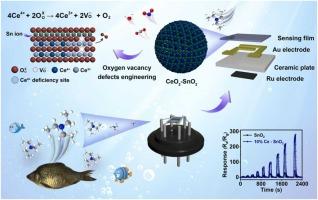Engineering oxygen vacancy defects on a CeO2-SnO2 micro-nano heterostructure for rapid triethylamine detection and fish freshness monitoring
IF 3.7
1区 化学
Q1 CHEMISTRY, ANALYTICAL
引用次数: 0
Abstract
Oxygen vacancy defects on the surface of metal oxides can not only increase carrier density and facilitate electron transfer, but also increase more active sites, thereby significantly boosting the overall performance of sensors. In this study, a 3D bundle-like porous CeO2-SnO2 heterostructure with abundant oxygen vacancy defects composed of radially cross-bundled mesoporous nanorods is successfully prepared. The synergistic effects of composition regulation, Ce4 + /Ce3+ valence engineering, and increased oxygen vacancy defects in the micro-nano structure enhance electron transfer at the interface, creating more active sites for triethylamine (TEA) capture. Consequently, the micro-nano structure shows an outstanding response value of 151.12 towards 100 ppm TEA at 157 °C, about six times higher than SnO2, with excellent selectivity, fast response/recovery times (9 s/123 s), superior anti-interference ability, and long-term stability. Also, the sensor can achieve a response value of 11.24 for TEA detection in gases from five-day-stored crucian carp at room temperature, showing potential for freshness monitoring. This work presents an effective strategy to develop TEA sensors for practical applications by using oxygen valence engineering and tailoring multi-scale pore structures in MOF-derived heterostructures.

CeO2-SnO2微纳异质结构上的工程氧空位缺陷用于三乙胺快速检测和鱼类新鲜度监测
金属氧化物表面的氧空位缺陷不仅可以增加载流子密度,促进电子转移,还可以增加更多的活性位点,从而显著提高传感器的整体性能。在本研究中,成功制备了由径向交叉束状介孔纳米棒组成的具有丰富氧空位缺陷的三维束状多孔CeO2-SnO2异质结构。微纳结构中组成调控、Ce4+/Ce3+价态工程和氧空位缺陷增加的协同效应增强了界面上的电子转移,为三乙胺(TEA)捕获创造了更多的活性位点。结果表明,该微纳结构在157℃下对100 ppm TEA的响应值为151.12,是SnO2的6倍,具有优异的选择性、快速的响应/恢复时间(9 s/123 s)、优越的抗干扰能力和长期稳定性。此外,该传感器在室温下对储存5天的鲫鱼气体进行TEA检测的响应值可达11.24,具有监测新鲜度的潜力。本研究提出了一种有效的策略,通过氧价工程和定制mof衍生异质结构的多尺度孔隙结构来开发具有实际应用价值的TEA传感器。
本文章由计算机程序翻译,如有差异,请以英文原文为准。
求助全文
约1分钟内获得全文
求助全文
来源期刊

Sensors and Actuators B: Chemical
工程技术-电化学
CiteScore
14.60
自引率
11.90%
发文量
1776
审稿时长
3.2 months
期刊介绍:
Sensors & Actuators, B: Chemical is an international journal focused on the research and development of chemical transducers. It covers chemical sensors and biosensors, chemical actuators, and analytical microsystems. The journal is interdisciplinary, aiming to publish original works showcasing substantial advancements beyond the current state of the art in these fields, with practical applicability to solving meaningful analytical problems. Review articles are accepted by invitation from an Editor of the journal.
 求助内容:
求助内容: 应助结果提醒方式:
应助结果提醒方式:


